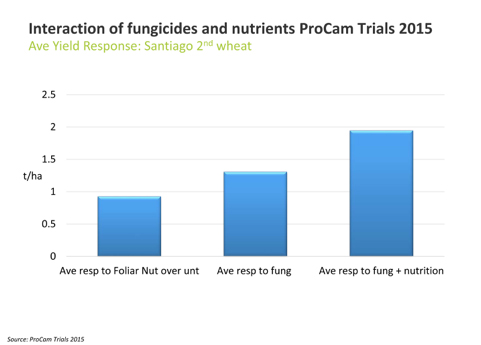GROWERS URGED TO WATCH FALLING P AND K INPUTS20 January 2017
UK P and K inputs are no longer keeping up with off-takes, suggests a ProCam 4Cast analysis of recorded wheat yields over the last six years. In the high yielding years of 2014 and 2015, in particular, levels removed in crops exceeded average amounts applied which could now be lowering soil availability of these vital nutrients.
“Growers have got to target high yields to combat low grain prices so this is a particularly worrying trend,” ProCam head of crop production Nick Myers told visitors to a recent soil conference organised by the company.
“Adequate levels of phosphate and potash are essential to avoid growth checks but soil indices around 2 are also needed to ensure optimum N utilisation.”
As commodity prices are squeezed the pressure is on to look at all areas to reduce costs but the basics have to be right to optimise yields, he pointed out.


“Phosphate applications and take-off in the grain were more or less in balance last year at around 55kg/ha for both but when you add in the straw, take-off was more like 85kg/ha –a 30kg/ha shortfall.
“With Potash we saw average applications of just below 70kg/ha yet the take off in the grain alone was around 80kg/ha. With straw included it rose to 105kg/ha – a 35kg/ha deficit.”
Once soil P and K levels are run down they are difficult and costly to bring back and as well as affecting yields, could potentially impact on plant health and disease control, Nick Myers pointed out.
“ProCam has carried out numerous trials over the years looking at the relationship between variety, plant nutrition and a crop’s ability to make full use of applied fungicides.
“In one such trial strategic use of foliar applied nutrition products combined with a range of fungicide programmes produced significant yield increases over the fungicide programmes alone delivering a 5 to 1 return on the nutrient input costs.”

Modern high performance varieties, in particular need to be fed properly to get the most out of them with Sulphur increasingly important, he added.
“Atmospheric Sulphur levels have been declining for many years yet is an essential element for plant growth. Not only is it important for overall yields it is also essential for producing the protein levels required for premium wheat milling specifications.
“ProCam 4Cast shows average sulphur applications to winter wheat have been steadily rising in recent years from an average of around 20kg/ha in 2010 to just over 30kg/ha in 2015 but there is still room for improvement in this area with some growers still not appreciating how important it is.”
4Cast also shows that whilst the company’s top 25% of growers produced 1.4t/ha more wheat than the company’s average over the last 16 years – and 2.2t/ha more than the Defra national average for the period – their proportional spend on inputs is no different to the rest.
“The top 25% tend to grow less second wheats, a higher proportion of milling varieties and rely less on the plough in favour of minimal cultivation, but their balance of variable cost inputs is virtually the same as that for average producers.”
It implies that the main differentiating factor is management, he said
“Whilst correcting the P and K deficit and using Nitrogen and Sulphur wisely are important, looking to make incremental gains across all areas of crop production is key to boosting biomass and yields.
“That means making best use of existing knowledge and adopting new technology only where there is a proven cost benefit.
“There is no silver bullet – focusing on improving all management areas that can contribute to the production of economically optimum yields is the key to future sustainability.”